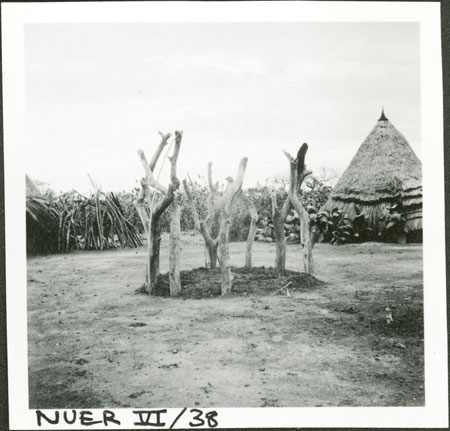Nuer kraal fire

58 x 55 mm | Print gelatin silver
There are records relating to alternative images that we do not have scans for in the database:
1998.355.266.1 - Negative film nitrate , (58 x 55 mm )
1998.355.266.1 - Negative film nitrate , (58 x 55 mm )
Date of Print:
Unknown
Previous PRM Number:
EP.N.VI.38
Previous Other Number:
3
Accession Number:
1998.355.266.2
Description:
A cattle-dung fire surrounded by thick forked branches placed in the centre of the cattle pen in a homestead.
Such fires or smudges were made to help keep away pests such as mosquitos from cattle during the rainy season, and sometimes during the dry season, by enveloping the kraal in thick smoke.
Such fires, known as gol, were metaphorically associated with both the home, family and lineage, and the ash was rubbed on cattle before blessing or sacrifice.
Photographer:
Edward Evan Evans-Pritchard
Date of Photo:
1935 - 1936
Region:
[Southern Sudan] ?Upper Nile ?Wahda
Group:
Nuer ?Gaajok ?Leek
PRM Source:
Edward Evan Evans-Pritchard
Acquired:
Donated 1966
Other Owners:
E. E. Evans-Pritchard Collection
Class:
Fire
Keyword:
Fire Accessory
Documentation:
Original catalogue lists in Manuscript Collections. Additional material in related documents files. [CM 27/9/2005]
Primary Documentation:
Accession Book Entry [p.
98] 1966.27 [1 - 24] G[ift] PROFESSOR E.
E.
EVANS-PRITCHARD; INST.
OF SOCIAL ANTHROPOLOGY, 51 BANBURY RD.
OXFORD 1966.27.1-16 S.
SUDAN.
NUER TRIBE.
Sixteen negative albums containing negatives
and
prints of photographs taken by donor during field-work.
All listed in albums.
Added Accession Book Entry - [p.
98 in right hand column, in pencil] Catalogue room.
Manual Catalogues [index taken from album book VI, ms ink] - 38. gol in kraal
Note on print reverse ms pencil - "3" & print front border ms ink - "NUER VI/38"
Manual Catalogues [index taken from album book VI, ms ink] - 38. gol in kraal
Note on print reverse ms pencil - "3" & print front border ms ink - "NUER VI/38"
Other Information:
In E.
E.
Evans-Pritchard's Nuer Religion (Oxford University Press 1974 [1957]), page 262 he notes that 'gol, the household smudge which symbolizes for the Nuer the home in various senses.
Gol means primarily the home in a domestic sense.
It is identified with the father of a family, gol so-and-so being the 'home' of that man and hence his 'family' also.
But it can also be used for the lineage, the 'family' in that wider sense.
The ash comes from the gol which represents the family or the lineage, and the officiant who places it on the animal's back represents, according to the type of sacrifice, either the members of the family or the members of the lineage.' [Chris Morton 29/6/2004]
Recorder:
Christopher Morton [29/6/2004] [Southern Sudan Project]

